Universal Immunization Programme (UIP)
- Universal Immunization Programme (UIP) is one of the largest public health programsin the World targeting close of 2.67 crore newborns and 2.9 crore pregnant women annually.
- Under UIP, immunization is providing free of cost against 12 vaccine-preventable diseases:
- Nationally against 9 diseases – Diphtheria, Pertussis, Tetanus, Polio, Measles, Rubella, a severe form of Childhood Tuberculosis, Hepatitis B and Meningitis & Pneumonia caused by Hemophilus Influenza type B.
- The government of India provides several vaccines to infants, children and pregnant women through the Universal Immunisation Programme.
- Sub-nationally against 3 diseases – Rotavirus diarrhea, Pneumococcal Pneumonia and Japanese Encephalitis; of which Rotavirus vaccine and Pneumococcal Conjugate vaccine are in process of expansion while JE vaccine is provided only in endemic districts.
- A child is said to be fully immunized if a child receives all due vaccines as per the national immunization schedule within 1st year age of the child.
- The two major milestones of UIP have been the elimination of polio in 2014 and maternal and neonatal tetanus elimination in 2015.
What is immunization
Immunization
Immunization is the process whereby a person is made immune or resistant to an infectious disease, typically by the administration of a vaccine. Vaccines are substances that stimulate the body’s own immune system to protect the person against subsequent infection or disease.
National Immunization Schedule/NIS
| Vaccine | Dose | Recommended Age | Volume | Route of Administration | Site |
|---|---|---|---|---|---|
| BCG | Single | At birth or as early as possible till one year of age | 0.1ml (0.05ml until 1 month age) | Intradermal | LEFT upper arm |
| Hepatitis B | Birth Dose | At birth or as early as possible within 24 hours | 0.5 mL | Intramuscular | Antero-lateral side of LEFT mid-thigh |
| OPV-0 | Zero Dose | At birth or as early as possible within the first 15 days | 2 Drops | Oral | mouth |
| OPV 1st, 2nd & 3rd | 1st, 2nd & 3rd | 1st At 6 weeks, 2nd at 10 weeks & 3rd at14 weeks (OPV can be given till 5 years of age) | 2 Drops | Oral | mouth |
| Pentavalent 1st, 2nd & 3rd | 1st, 2nd & 3rd | 1st At 6 weeks, 2nd at 10 weeks & 3rd at14 weeks (Pentavalent can be given till one year of age) | 0.5 mL | Intramuscular | Antero-lateral side of LEFT mid-thigh |
| Rotavirus/RVV | 3 doses (1st, 2nd & 3rd ) | 1st At 6 weeks, 2nd at 10 weeks & 3rd at14 weeks (Note: RVV can be given till one year of age) | 5 Drops | Oral | Mouth |
| PCV | 3 doses(1st, 2nd & Booster Dose | 1st At 6 weeks, 2nd at 14 weeks & Booster at 9 month | 0.5 mL | Intramuscular | Antero-lateral side of RIGHT midthigh |
| IPV | Two dose | 1st at 6 2nd at14 weeks of age | 0.1 mL | Intradermal | RIGHT upper arm |
| Measles/ MR* | 2 doses(1st, & Booster Dose) | 1st at 9 completed months-12 months, Booster Dose at 16-24 month Note: MR can be given till 5 years of age | 0.5 mL | Subcutaneous | RIGHT upper arm |
| JE* | 2 doses(1st, & 2nd Dose) | 1st at 9 completed months-12 months, Booster Dose at 16-24 month | 0.5 mL | Subcutaneous | LEFT upper arm |
| DPT | 2 Doses (1st booster, & 2nd Booster) | 1st booster:16-24 months 2nd Booster: 5-6 yrs | 0.5 mL | Intramuscular | 1st booster: at Antero-lateral side of LEFT mid-thigh 2nd Booster: Intramuscular (upper arm) |
| To Pregnant women | prepared by ThePharmapedia Team | ||||
| TT | 1st booster, 2nd & Booster | 1st: Early in pregnancy 2nd: 4 weeks after 1st dose Booster: If received 2 TT doses in pregnancy within the last 3 years | 0.5 mL | Intramuscular | upper arm |
Note: JE* vaccine is given only in endemic districts.
National Immunization (टीकाकरण) Schedule
Easy to remember for Pharmacy & Nursing students
| Age | Vaccines given |
|---|---|
| At Birth | BCG, OPV-0 Dose, Hepatitis B birth dose (within 24 hrs after birth) |
| 6 Weeks | OPV-1, Pentavalent-1, RVV-1; fIPV-1, PCV-1* |
| 10 Weeks | OPV-2, Pentavalent-2, RVV-2 |
| 14 Weeks | OPV-3, Pentavalent-3, RVV-3, fIPV-2, PCV-2* |
| 9-12 Months | MR-1, PCV-Booster, JE-1# |
| 16-24 months | MR-2, JE-2# , DPT-Booster-1, OPV-Booster |
| 5-6 yrs | DPT-Booster-2 |
| Prepared by The Pharmapedia Team | |
| 10 yrs & 16 yrs | TT |
| Pregnant Woman | TT-1, TT-2 or TT Booster |
Mission Indradhanush
- Mission Indradhanush (MI) was launched in December 2014 and aims at increasing the full immunization coverage to children to 90%.
- Under this drive focus is given on pockets of low immunization coverage and hard to reach areas where the proportion of unvaccinated and partially vaccinated children is highest.
- A total of six phases of Mission Indradhanush have been completed covering 554 districts across the country.
- It was also identified as one of the flagship schemes under Gram Swaraj Abhiyan (16,850 villages across 541 districts) and Extended Gram Swaraj Abhiyan (48,929 villages across 117 aspirational districts).
- While the first two phases of Mission Indradhanush resulted in 6.7% increase in full immunization coverage in a year, a recent survey carried out in 190 districts covered in Intensified Mission Indradhanush (5th phase of Mission Indradhanush) shows 18.5% points increase in full immunization coverage as compared to NFHS-4 survey carried out in 2015-16.
Vaccines provided under UIP
BCG
- BCG stands for Bacillus Calmette-Guerin vaccine. It is given to infants to protect them from tubercular meningitis and disseminated TB.
- When to give – BCG vaccine is given at birth or as early as possible till 1year.
- Route and site- BCG is given as an intradermal injection in the left upper arm.
OPV
- OPV stands for Oral Polio Vaccine. It protects children from poliomylitis.
- When to give- OPV is given at birth called zero dose and three doses are given at 6, 10 and 14 weeks. A booster dose is given at 16-24 months of age.
- Route and site – OPV is given orally in the form of two drops.
Hepatitis B vaccine
- Hepatitis B vaccine protects from Hepatitis B virus infection.
When to give- Hepatitis B vaccine is given at birth or as early as possible within 24 hours. Subsequently 3 dose are given at 6, 10 and 14 weeks in combination with DPT and Hib in the form of pentavalent vaccine.
Route and site- Intramuscular injection is given at anterolateral side of mid thigh
Pentavalent Vaccine
- Pentavalent vaccine is a combined vaccine to protect children from five diseases Diptheria, Tetanus, Pertusis, Haemophilis influenza type b infection and Hepatitis B.
When to give – Three doses are given at 6, 10 and 14 weeks of age (can be given till one year of age).
Route and site-Pentavalent vaccine is given intramuscularly on the anterolateral side of mid-thigh
Rotavirus Vaccine
- RVV stands for Rotavirus vaccine. It gives protection to infants and children against rotavirus diarrhoea. It is given in select states.
When to give – Three doses of vaccine are given at 6, 10, 14 weeks of age (can be given at one year of age).
Route and site-5 drops of liquid vaccine or 2.5 ml (lyophilized vaccine) are given orally.
PCV
- PCV stands for Pneumococcal Conjugate Vaccine. It protects infants and young children against disease caused by the bacterium Streptococcus pneumoniae.
- When to give – The vaccine is given as two primary doses at 6 & 14 weeks of age followed by a booster dose at 9-12 months of age
- Route and site- PCV is given as intramuscular (IM) injection in antero- lateral side of mid- thigh. It should be noted that pentavalent vaccine and PCV
fIPV
- fIPV stands for Fractional Inactivated Poliomylitis Vaccine. It is used to boost the protection against poliomylitis.
When to give- Two fractional doses of IVP are given intradermally at 6 and 14 weeks of age.
Route and site- It is given as intradermal injection at right upper arm.
Measles/ MR vaccine
- Measles vaccine is used to protect children from measles. In few states Measles and Rubella a combined vaccine is given to protect from Measles and Rubella infection.
When to give-First dose of Measles or MR vaccine is given at 9 completed months to12 months (vaccine can be given up to 5 years if not given at 9-12 months age) and second dose is given at 16-24 months.
Route and site – Measles Vaccine is given as subcutaneous injection in right upper arm.
JE vaccine
- JE stands for Japanese encephalitis vaccine. It gives protection against Japanese Encephalitis disease. JE vaccine is given in select districts endemic for JE after the campaign.
When to given- JE vaccine is given in two doses first dose is given at 9
completed months-12 months of age and second dose at 16-24 months of age.
- Route and site- Live attenuated vaccine is given as subcutaneous injection in left upper arm and killed vaccine is given as intramuscular injection in anterolateral aspect of mid- thigh.
DPT booster
- DPT is a combined vaccine; it protects children from Diphtheria, Tetanus and Pertussis.
When to give -DPT vaccine is given at 16-24 months of age is called as DPT first booster and DPT 2nd booster is given at 5-6 years of age.
Route and site- DPT first booster is given as intramuscular injection in antero-lateral side of mid-thigh in left leg. DPT second booster is given as intramuscular injection in left upper arm.
Tetanus and adult diphtheria (Td) vaccine
- TT vaccine has been replaced with Td vaccine in UIP to limit the waning immunity against diphtheria in older age groups.
When to give- Td vaccine is administered to adolescents at 10 and 16 years of age and to pregnant women.
Pregnant women- Td-1 is given early in pregnancy as first dose and 4 weeks after Td1, second dose of Td as Td-2 is given. Td- Booster is given, if pregnant woman has received 2 TT/Td doses in a pregnancy within the last 3 years.* Intra-muscular Upper Arm
Route and site- Td is given as intramuscular injection in upper arm.
New vaccines under UIP
- Inactivated Polio Vaccine (IPV): IPV has been introduced in UIP as part of Global Polio end-game strategy, to mitigate the risk associated with tOPV to bOPV switch. IPV was introduced in November 2015 initially in 6 states, which was expanded across the country by April 2016.
- Rotavirus vaccine (RVV): RVV has been introduced to reduce mortality and morbidity caused by Rotavirus diarrhoea in March 2016. It has been introduced in 11 states (Andhra Pradesh, Haryana, Himachal Pradesh, Jharkhand, Odisha, Assam, Tripura, Rajasthan, Tamil Nadu, Madhya Pradesh and Uttar Pradesh). The vaccine will be expanded across the country in 2019-20.
- Measles-Rubella (MR) vaccine: India is committed to the goal of measles elimination and rubella control and to achieve the goal MR vaccine was introduced in the country through a campaign mode in a phased manner in 2017. MR campaign target around 41 crore children in the age group of 9 months to 15 years (covering ⅓ of the total population of the country) followed by 2 doses in routine immunization at 9-12 months and 16-24 months. Rubella component is now under routine immunization as MR vaccine.
- Pneumococcal Conjugate Vaccine (PCV): PCV has been launched in May 2017 for reducing Infant mortality and morbidity caused by pneumococcal pneumonia. It has been introduced in Bihar, Himachal Pradesh, Madhya Pradesh, 19 districts of Uttar Pradesh and 18 districts of Rajasthan.
- Tetanus and adult diphtheria (Td) vaccine: TT vaccine has been replaced with Td vaccine in UIP to limit the waning immunity against diphtheria in older age groups. Td vaccine to be administered to adolescents at 10 and 16 years of age and to pregnant women.
Vaccination sites of multiple vaccines under immunization
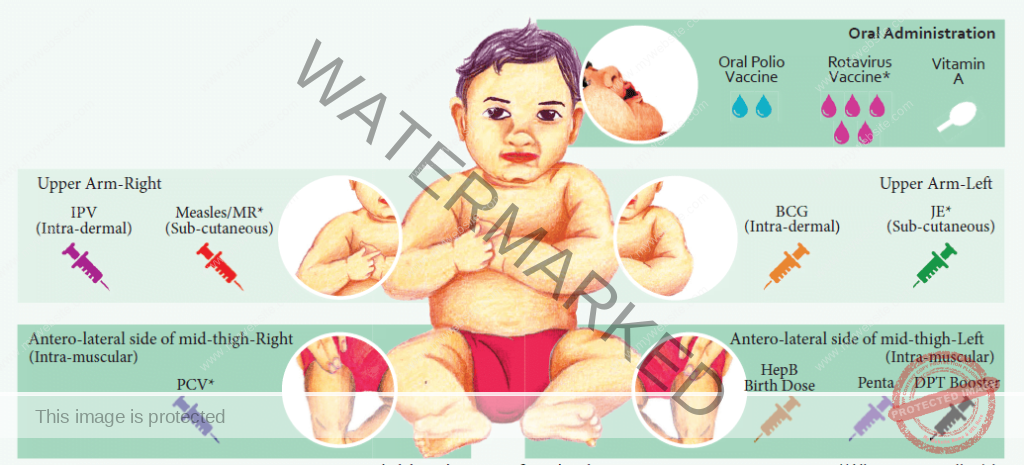
FAQ on Vaccine and Immunization
1. What is immunity?
Immunity refers to resistance against infection caused by microorganisms (bacteria and viruses) and their products (toxins).
2. What is immunization?
Immunization is the process whereby a person is made immune or resistant to an infectious disease, typically by the administration of a vaccine. Vaccines stimulate the body’s own immune system to protect the person against subsequent infection or disease.
3. How do vaccines protect from disease-causing organisms?
Vaccines contain either weakened or killed versions of viruses or bacteria, or an antigenic substance prepared from the causative agent, or a synthetic substitute.
Once administered in the body by injection, mouth or by aerosol, stimulate the immune response to produce “antibodies” targeting those infectious agents, thereby producing protection against infections. Each vaccine provides immunity against a particular disease.
4. What are the various types of vaccines?
Vaccines can be categorized on the basis of their composition, Broadly, there are four types of vaccines
5. Which vaccines are currently given to a child in India’s Universal Immunization Programme and against which diseases these vaccines prevent?
Under India’s Universal Immunization Programme 12 different vaccines are provided to beneficiaries free of cost, through government health system. These are – BCG, OPV, Hepatitis B, Pentavalent, Rotavirus, PCV, IPV, Measles/MR, JE, DPT, and TT.
6. What is the meaning of a fully immunized child?
A fully immunized child is one who has received all vaccines recommended in the National Immunization Schedule in required doses, before completing one year of age.
7. What is the meaning of a completely immunized child?
A child who has received all vaccines recommended for the first and second year in the National Immunization Schedule is said to be completely immunized.
a. First-year: One dose of BCG, Measles/MR* and JE vaccines, 3 doses of OPV, Pentavalent vaccine, Rotavirus vaccine and PCV, and 2 doses of IPV
b. Second year: Second dose of Measles/ MR and JE vaccines*, and one booster dose of OPV and DPT
8. What are left outs and drop outs?
Left outs are those children who have never been vaccinated or reached (thus remaining unimmunized);Drop outs are those children who started vaccination but did not complete the schedule (thus remaining partially immunized).
9. What are the upper age limits for various vaccines?
According to National Immunization Schedule, some vaccines have an upper age limit for administration and these vaccines should not be administered once that age limit is crossed.
The vaccines should be given till the following ages as per UIP guidelines:
BCG: up to one year of age
OPV: up to five years (OPV zero dose till 15 days of birth)
Measles/MR: up to five years (in MR campaigns, the vaccine is given to 9 months to 15 years age group)
DPT: up to 7 years
JE: up to 15 years
For pentavalent, IPV, PCV and Rotavirus vaccines, if at least one dose is given before one year of age, then remaining doses can be administered and schedule must be completed irrespective of the age of child. If the first dose is not administered before one year of age, then these vaccines cannot be administered to the child under UIP
10. What vaccines should be given to a new-born?
According to National Immunization Schedule, one dose each of three vaccines, OPV, BCG and Hepatitis B, should be given to new-borns irrespective of the place of delivery. This is recommended for all institutional and non-institutional deliveries, in both public and private sectors.
11. Is there any time limit for these vaccines recommended for newborns?
Yes. Time limit for vaccines recommended for new-borns is as follows:
Hepatitis B (known as “birth dose”): should be given within 24 hours of birth to protect the new-born from possible Hepatitis B infection that gets transferred from mother during delivery. If birth dose of Hepatitis B vaccine is given beyond 24 hours, then it will not provide this protection. However, maximum protection against Hepatitis B transmission is provided if the vaccine is given within 12 hours of birth.
OPV (known as “zero dose”): should be given within 15 days of birth, day of birth taken as day zero.
BCG: should be given as early as possible after birth to provide maximum protection from childhood tuberculosis infection. BCG vaccine should not be given to the child beyond one year of age.
Join WhatsApp channel to get latest Job notification, Study material, Previous paper, MCQ quiz, Admission alerts & News etc. for Pharmacy aspirants.
Subscribe our Telegram channel for Pharmacy Notes, MCQ Quiz, , Previous paper, Admission alerts & News etc. for Pharmacy professionals.
Join Telegram group for all Pharmacy books, Pharmacopoeia (IP, USP, BP), Pharmacy Notes, Previous Year Question papers in pdf format.


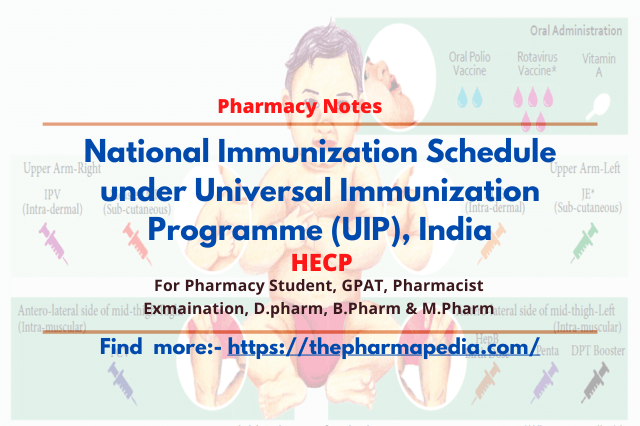

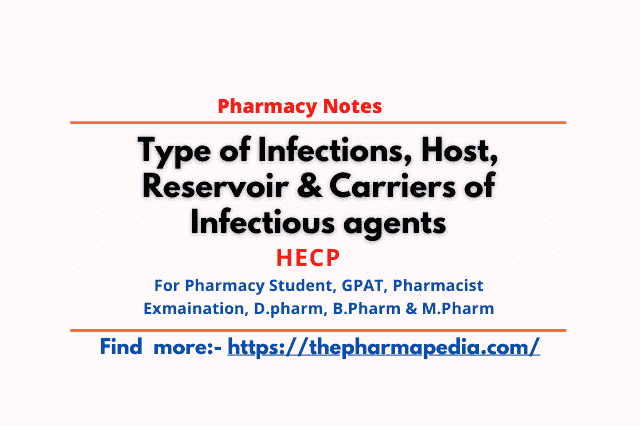
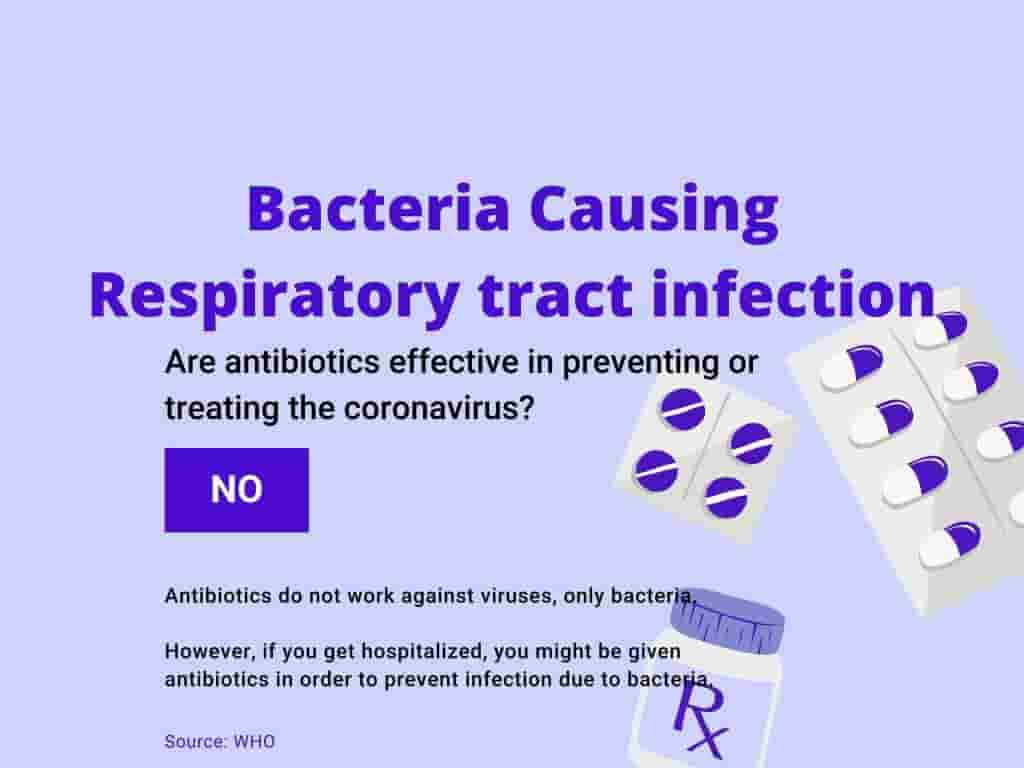
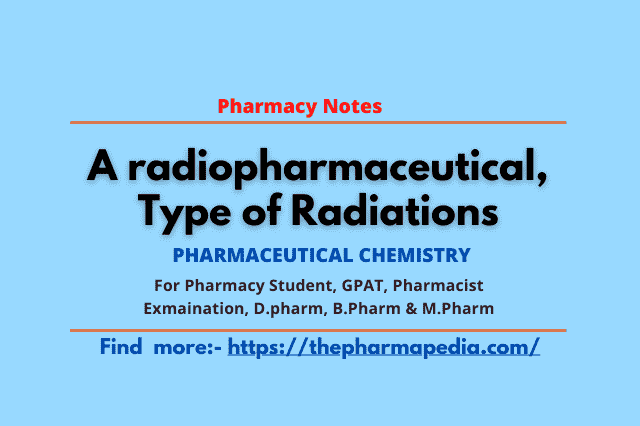
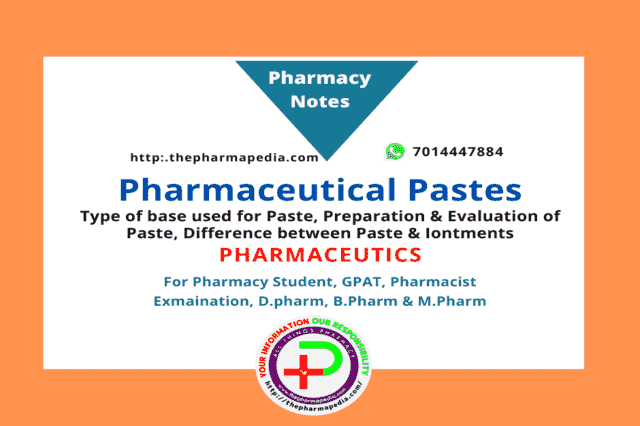

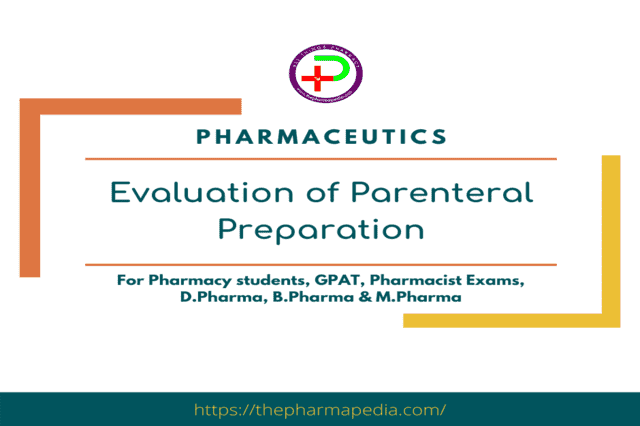

Pingback: ISRO Pharmacist Previous Year Question Paper Solved 2017 | The Pharmapedia